
York city walls
Encyclopedia
The English
city of York
has, since Roman
times, been defended by walls
of one form or another. To this day, substantial portions of the walls remain, and York has more miles of intact wall than any other city in England. They are known variously as York City Walls, the Bar walls and the Roman walls (though this last is a misnomer as very little of the extant stonework is of Roman origin, and the course of the wall has been substantially altered since Roman times).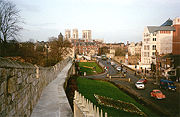
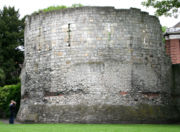 The Multangular Tower in the Museum Gardens
The Multangular Tower in the Museum Gardens
is the most noticeable and intact structure remaining from the Roman walls. It was constructed as part of a series of eight similar defensive towers, possibly built on the orders of the Roman Emperor
Septimius Severus
, or Constantine the Great who both lived in Eboracum
, as Roman York was known, from 209 to some point in the Seventh Century. The walls are almost certainly the creation of Septimius Severus
, however the Multangular Tower is probably a later addition of Constantine the Great around AD 310-20. It has ten sides and is almost 30 feet (9.1 m) tall. The lower courses are original Roman stonework, though the upper course with arrowslits is a later medieval addition.
The Multangular Tower and the other seven similar towers were, however, a late addition to the walls. The original walls were built around 71 AD, when the Romans
erected a fort (castra
) occupying about 50 acre
s or 21.5 hectares near the banks of the River Ouse
. The rectangle of walls was built as part of the fort's defences. The foundations and the line of about half of these Roman walls form part of the existing walls, as follows:
The line of the rest of the Roman wall went south-west from the east corner, crossing the via principalis of the fortress where King's Square is now located. The south corner was in what is now Feasegate, and from here the wall continued northwest to the west corner. The point where the wall crossed the via praetoria is marked by a plaque in St Helen's Square near the Mansion House
.
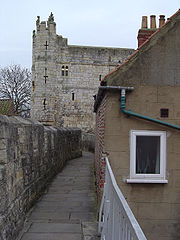 The Danes occupied the city in 867. By this time the Roman defences were in poor repair, and the Danes demolished all the towers save the Multangular Tower and restored the walls.
The Danes occupied the city in 867. By this time the Roman defences were in poor repair, and the Danes demolished all the towers save the Multangular Tower and restored the walls.
The majority of the remaining walls, which encircle the whole of the medieval
city, date from the 12th - 14th century, with some reconstruction carried out in the 19th century and later. From the east corner of the Roman walls, the medieval wall extends to Layerthorpe
Bridge. After the bridge, the King's Fishpool, a swamp created by the Normans
' dam
ming of the River Foss
, provided adequate security for the city, and no walls were ever built in this area.
The walls resume beyond the now canal
ised Foss at the Red Tower, a brick building which has been much restored over the years. They continue south and west around the Walmgate area, terminating in another tower (Fishergate Postern), near York Castle
, which was formerly surrounded by its own walls and a moat
.
A small stretch of wall on the west side of Tower Gardens terminates at Davy Tower, another brick tower located next to the River Ouse
). This originally ran up to the castle walls, with a postern
on Tower Street.
Beyond the Ouse, the walls resume at Skeldergate, where there was once another postern. They climb past Baile Hill, take a right turn and proceed north-west parallel to the Inner Ring Road. Near the railway station
, they turn right again in a north-easterly direction, finishing at Barker Tower on the Ouse.
Barker Tower was once linked by a chain across the river, parallel to the nineteenth-century Lendal Bridge. A small stretch of wall then leads to the entrance to Museum Gardens, the Multangular Tower and the original line of the Roman walls.
Today the walls are a scheduled ancient monument
and a grade 1 listed building.
 The walls are punctuated by four main gatehouse
The walls are punctuated by four main gatehouse
s, or 'bars', (Bootham Bar, Monk Bar, Walmgate Bar and Micklegate Bar below). These restricted traffic in medieval times, and were used to extract tolls
, as well as being defensive positions in times of war.
 This four-story gatehouse is the tallest and most elaborate of the four, and was built in the early 14th century. It was intended as a self-contained fort, and each floor is capable of being defended separately. The current gatehouse was built to replace a 12th century gate known as Munecagate, which stood 100 yards (91.4 m) to the north-west, on the site of the Roman gate porta decumana - that location is indicated by a slight dip in the earth rampart. Today, Monk Bar houses the Richard III Museum
This four-story gatehouse is the tallest and most elaborate of the four, and was built in the early 14th century. It was intended as a self-contained fort, and each floor is capable of being defended separately. The current gatehouse was built to replace a 12th century gate known as Munecagate, which stood 100 yards (91.4 m) to the north-west, on the site of the Roman gate porta decumana - that location is indicated by a slight dip in the earth rampart. Today, Monk Bar houses the Richard III Museum
and retains its portcullis
in working order.
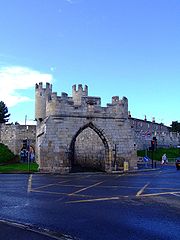 Most of Walmgate Bar was built during the 14th century, although the inner gateway dates from the 12th century. The Bar's most notable feature is its barbican
Most of Walmgate Bar was built during the 14th century, although the inner gateway dates from the 12th century. The Bar's most notable feature is its barbican
, which is the only one surviving on a town gate in England. It also retains its portcullis
and 15th century oak doors. On the inner side, an Elizabethan
house, supported by stone pillars, extends out over the gateway. The Bar has been repaired and restored many times over the years, most notably in 1648, following the 1644 Siege of York
in the English Civil War
when it was bombarded by cannon fire, and in 1840 after it had suffered years of neglect. It was also damaged in 1489 when, along with Fishergate Bar, it was burnt by rebels who were rioting over tax raises.
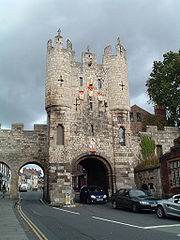 The name of this four-storey-high gatehouse is from the Old Norse
The name of this four-storey-high gatehouse is from the Old Norse
'mykla gata' or 'great street', and leads onto Micklegate
('gate' is Norwegian
for 'street
' remaining from Viking
influence in York). It was the traditional ceremonial gate for monarchs entering the city, who, in a tradition dating to Richard II
in 1389, touch the state sword when entering the gate.
A 12th century gatehouse was replaced in the 14th century with a heavy portcullis and barbican.
The upper two floors contain living quarters, which today are a museum of the bar, and the city. Its symbolic value led to traitors' decapitated heads being displayed on the defences. Heads left there to rot included: Henry Hotspur Percy (1403), Henry Scrope, 3rd Baron Scrope of Masham
(1415), Richard Plantagenet, 3rd Duke of York
(1461), and Thomas Percy, 7th Earl of Northumberland
(1572).
England
England is a country that is part of the United Kingdom. It shares land borders with Scotland to the north and Wales to the west; the Irish Sea is to the north west, the Celtic Sea to the south west, with the North Sea to the east and the English Channel to the south separating it from continental...
city of York
York
York is a walled city, situated at the confluence of the Rivers Ouse and Foss in North Yorkshire, England. The city has a rich heritage and has provided the backdrop to major political events throughout much of its two millennia of existence...
has, since Roman
Roman Britain
Roman Britain was the part of the island of Great Britain controlled by the Roman Empire from AD 43 until ca. AD 410.The Romans referred to the imperial province as Britannia, which eventually comprised all of the island of Great Britain south of the fluid frontier with Caledonia...
times, been defended by walls
Defensive wall
A defensive wall is a fortification used to protect a city or settlement from potential aggressors. In ancient to modern times, they were used to enclose settlements...
of one form or another. To this day, substantial portions of the walls remain, and York has more miles of intact wall than any other city in England. They are known variously as York City Walls, the Bar walls and the Roman walls (though this last is a misnomer as very little of the extant stonework is of Roman origin, and the course of the wall has been substantially altered since Roman times).

Roman walls

York Museum Gardens
The York Museum Gardens are botanic gardens in the centre of York, England, beside the River Ouse. They cover an area of of the former grounds of St Mary's Abbey, and were created in the 1830s by the Yorkshire Philosophical Society along with the Yorkshire Museum which they contain.The gardens are...
is the most noticeable and intact structure remaining from the Roman walls. It was constructed as part of a series of eight similar defensive towers, possibly built on the orders of the Roman Emperor
Roman Emperor
The Roman emperor was the ruler of the Roman State during the imperial period . The Romans had no single term for the office although at any given time, a given title was associated with the emperor...
Septimius Severus
Septimius Severus
Septimius Severus , also known as Severus, was Roman Emperor from 193 to 211. Severus was born in Leptis Magna in the province of Africa. As a young man he advanced through the customary succession of offices under the reigns of Marcus Aurelius and Commodus. Severus seized power after the death of...
, or Constantine the Great who both lived in Eboracum
Eboracum
Eboracum was a fort and city in Roman Britain. The settlement evolved into York, located in North Yorkshire, England.-Etymology:The first known recorded mention of Eboracum by name is dated circa 95-104 AD and is an address containing the Latin form of the settlement's name, "Eburaci", on a wooden...
, as Roman York was known, from 209 to some point in the Seventh Century. The walls are almost certainly the creation of Septimius Severus
Septimius Severus
Septimius Severus , also known as Severus, was Roman Emperor from 193 to 211. Severus was born in Leptis Magna in the province of Africa. As a young man he advanced through the customary succession of offices under the reigns of Marcus Aurelius and Commodus. Severus seized power after the death of...
, however the Multangular Tower is probably a later addition of Constantine the Great around AD 310-20. It has ten sides and is almost 30 feet (9.1 m) tall. The lower courses are original Roman stonework, though the upper course with arrowslits is a later medieval addition.
The Multangular Tower and the other seven similar towers were, however, a late addition to the walls. The original walls were built around 71 AD, when the Romans
Roman Empire
The Roman Empire was the post-Republican period of the ancient Roman civilization, characterised by an autocratic form of government and large territorial holdings in Europe and around the Mediterranean....
erected a fort (castra
Castra
The Latin word castra, with its singular castrum, was used by the ancient Romans to mean buildings or plots of land reserved to or constructed for use as a military defensive position. The word appears in both Oscan and Umbrian as well as in Latin. It may have descended from Indo-European to Italic...
) occupying about 50 acre
Acre
The acre is a unit of area in a number of different systems, including the imperial and U.S. customary systems. The most commonly used acres today are the international acre and, in the United States, the survey acre. The most common use of the acre is to measure tracts of land.The acre is related...
s or 21.5 hectares near the banks of the River Ouse
River Ouse, Yorkshire
The River Ouse is a river in North Yorkshire, England. The river is formed from the River Ure at Cuddy Shaw Reach near Linton-on-Ouse, about 6 miles downstream of the confluence of the River Swale with the River Ure...
. The rectangle of walls was built as part of the fort's defences. The foundations and the line of about half of these Roman walls form part of the existing walls, as follows:
- a section (the west corner, including the Multangular Tower) in the Museum Gardens
- the north-west and north-east sections between Bootham Bar and Monk Bar
- a further stretch between Monk Bar and the Merchant Taylors' HallMerchant Taylors' Hall, YorkThe Merchant Taylors' Hall in York, England, is a medieval guildhall near the city wall in the Aldwark area of the city.Constructed by the Fraternity of St John the Baptist in the 14th century, it received a new cladding in the 17th century. The main hall is 60 ft by 30ft, with 30ft ceilings...
, at the end of which the lower courses of the east corner of the Roman wall can be seen on the city-centre side of the existing wall.
The line of the rest of the Roman wall went south-west from the east corner, crossing the via principalis of the fortress where King's Square is now located. The south corner was in what is now Feasegate, and from here the wall continued northwest to the west corner. The point where the wall crossed the via praetoria is marked by a plaque in St Helen's Square near the Mansion House
Mansion House, York
The Mansion House in York, England is the home of the Lord Mayors of York during their term in office. It is situated on St Helen's Square, where York's Coney Street and Lendal intersect in the city centre. It is built in an early Georgian style. The foundation stone for the Mansion House was laid...
.
After the Romans

The majority of the remaining walls, which encircle the whole of the medieval
Middle Ages
The Middle Ages is a periodization of European history from the 5th century to the 15th century. The Middle Ages follows the fall of the Western Roman Empire in 476 and precedes the Early Modern Era. It is the middle period of a three-period division of Western history: Classic, Medieval and Modern...
city, date from the 12th - 14th century, with some reconstruction carried out in the 19th century and later. From the east corner of the Roman walls, the medieval wall extends to Layerthorpe
Layerthorpe
Layerthorpe is a former village and latterly industrial district to the north-east of the centre of the city of York, North Yorkshire, England. It is just outside the city walls of York.- Origin of the name :...
Bridge. After the bridge, the King's Fishpool, a swamp created by the Normans
Normans
The Normans were the people who gave their name to Normandy, a region in northern France. They were descended from Norse Viking conquerors of the territory and the native population of Frankish and Gallo-Roman stock...
' dam
Dam
A dam is a barrier that impounds water or underground streams. Dams generally serve the primary purpose of retaining water, while other structures such as floodgates or levees are used to manage or prevent water flow into specific land regions. Hydropower and pumped-storage hydroelectricity are...
ming of the River Foss
River Foss
The River Foss is an improved river in North Yorkshire, England, and a tributary of the River Ouse. It rises in the Foss Crooks woods near Oulston reservoir close to the village of Yearsley and runs south through the Vale of York to the Ouse...
, provided adequate security for the city, and no walls were ever built in this area.
The walls resume beyond the now canal
Canal
Canals are man-made channels for water. There are two types of canal:#Waterways: navigable transportation canals used for carrying ships and boats shipping goods and conveying people, further subdivided into two kinds:...
ised Foss at the Red Tower, a brick building which has been much restored over the years. They continue south and west around the Walmgate area, terminating in another tower (Fishergate Postern), near York Castle
York Castle
York Castle in the city of York, England, is a fortified complex comprising, over the last nine centuries, a sequence of castles, prisons, law courts and other buildings on the south side of the River Foss. The now-ruinous keep of the medieval Norman castle is sometimes referred to as Clifford's...
, which was formerly surrounded by its own walls and a moat
Moat
A moat is a deep, broad ditch, either dry or filled with water, that surrounds a castle, other building or town, historically to provide it with a preliminary line of defence. In some places moats evolved into more extensive water defences, including natural or artificial lakes, dams and sluices...
.
A small stretch of wall on the west side of Tower Gardens terminates at Davy Tower, another brick tower located next to the River Ouse
River Ouse, Yorkshire
The River Ouse is a river in North Yorkshire, England. The river is formed from the River Ure at Cuddy Shaw Reach near Linton-on-Ouse, about 6 miles downstream of the confluence of the River Swale with the River Ure...
). This originally ran up to the castle walls, with a postern
Postern
A postern is a secondary door or gate, particularly in a fortification such as a city wall or castle curtain wall. Posterns were often located in a concealed location, allowing the occupants to come and go inconspicuously. In the event of a siege, a postern could act as a sally port, allowing...
on Tower Street.
Beyond the Ouse, the walls resume at Skeldergate, where there was once another postern. They climb past Baile Hill, take a right turn and proceed north-west parallel to the Inner Ring Road. Near the railway station
York railway station
York railway station is a main-line railway station in the city of York, England. It lies on the East Coast Main Line north of London's King's Cross station towards Edinburgh's Waverley Station...
, they turn right again in a north-easterly direction, finishing at Barker Tower on the Ouse.
Barker Tower was once linked by a chain across the river, parallel to the nineteenth-century Lendal Bridge. A small stretch of wall then leads to the entrance to Museum Gardens, the Multangular Tower and the original line of the Roman walls.
Today the walls are a scheduled ancient monument
Scheduled Ancient Monument
In the United Kingdom, a scheduled monument is a 'nationally important' archaeological site or historic building, given protection against unauthorized change. The various pieces of legislation used for legally protecting heritage assets from damage and destruction are grouped under the term...
and a grade 1 listed building.
Bars

Gatehouse
A gatehouse, in architectural terminology, is a building enclosing or accompanying a gateway for a castle, manor house, fort, town or similar buildings of importance.-History:...
s, or 'bars', (Bootham Bar, Monk Bar, Walmgate Bar and Micklegate Bar below). These restricted traffic in medieval times, and were used to extract tolls
Toll road
A toll road is a privately or publicly built road for which a driver pays a toll for use. Structures for which tolls are charged include toll bridges and toll tunnels. Non-toll roads are financed using other sources of revenue, most typically fuel tax or general tax funds...
, as well as being defensive positions in times of war.
Bootham Bar
Although much of Bootham Bar was built in the 14th and 19th centuries, it also has some of the oldest surviving stonework, dating to the 11th century. It stands almost on the site of porta principalis dextra, the north western gate of Eboracum.Monk Bar

Richard III Museum
The Richard III Museum is located in the tallest of the four gatehouses, Monk Bar, in the historical city walls of York, England. It presents to visitors the life of Richard III, the last king of the Plantagenet dynasty....
and retains its portcullis
Portcullis
A portcullis is a latticed grille made of wood, metal, fibreglass or a combination of the three. Portcullises fortified the entrances to many medieval castles, acting as a last line of defence during time of attack or siege...
in working order.
Walmgate Bar

Barbican
A barbican, from medieval Latin barbecana, signifying the "outer fortification of a city or castle," with cognates in the Romance languages A barbican, from medieval Latin barbecana, signifying the "outer fortification of a city or castle," with cognates in the Romance languages A barbican, from...
, which is the only one surviving on a town gate in England. It also retains its portcullis
Portcullis
A portcullis is a latticed grille made of wood, metal, fibreglass or a combination of the three. Portcullises fortified the entrances to many medieval castles, acting as a last line of defence during time of attack or siege...
and 15th century oak doors. On the inner side, an Elizabethan
Elizabethan era
The Elizabethan era was the epoch in English history of Queen Elizabeth I's reign . Historians often depict it as the golden age in English history...
house, supported by stone pillars, extends out over the gateway. The Bar has been repaired and restored many times over the years, most notably in 1648, following the 1644 Siege of York
Siege of York
The Siege of York in 1644 was a prolonged contest for York during the English Civil War, between the Scottish Covenanter Army and the Parliamentarian Armies of the Northern Association and Eastern Association on the one hand, and the Royalist Army under the Marquess of Newcastle on the other...
in the English Civil War
English Civil War
The English Civil War was a series of armed conflicts and political machinations between Parliamentarians and Royalists...
when it was bombarded by cannon fire, and in 1840 after it had suffered years of neglect. It was also damaged in 1489 when, along with Fishergate Bar, it was burnt by rebels who were rioting over tax raises.
Micklegate Bar

Old Norse
Old Norse is a North Germanic language that was spoken by inhabitants of Scandinavia and inhabitants of their overseas settlements during the Viking Age, until about 1300....
'mykla gata' or 'great street', and leads onto Micklegate
Micklegate
Micklegate is a street in the City of York, England. The name means "Great Street", "Gate" coming from the Old Norse gata, or street. Micklegate lies on the Western side of the River Ouse, Yorkshire, and holds the southern entrance into the city, Micklegate Bar, through which many monarchs have...
('gate' is Norwegian
Norwegian language
Norwegian is a North Germanic language spoken primarily in Norway, where it is the official language. Together with Swedish and Danish, Norwegian forms a continuum of more or less mutually intelligible local and regional variants .These Scandinavian languages together with the Faroese language...
for 'street
Street
A street is a paved public thoroughfare in a built environment. It is a public parcel of land adjoining buildings in an urban context, on which people may freely assemble, interact, and move about. A street can be as simple as a level patch of dirt, but is more often paved with a hard, durable...
' remaining from Viking
Viking
The term Viking is customarily used to refer to the Norse explorers, warriors, merchants, and pirates who raided, traded, explored and settled in wide areas of Europe, Asia and the North Atlantic islands from the late 8th to the mid-11th century.These Norsemen used their famed longships to...
influence in York). It was the traditional ceremonial gate for monarchs entering the city, who, in a tradition dating to Richard II
Richard II of England
Richard II was King of England, a member of the House of Plantagenet and the last of its main-line kings. He ruled from 1377 until he was deposed in 1399. Richard was a son of Edward, the Black Prince, and was born during the reign of his grandfather, Edward III...
in 1389, touch the state sword when entering the gate.
A 12th century gatehouse was replaced in the 14th century with a heavy portcullis and barbican.
The upper two floors contain living quarters, which today are a museum of the bar, and the city. Its symbolic value led to traitors' decapitated heads being displayed on the defences. Heads left there to rot included: Henry Hotspur Percy (1403), Henry Scrope, 3rd Baron Scrope of Masham
Henry Scrope, 3rd Baron Scrope of Masham
Henry Scrope, 3rd Baron Scrope of Masham KG was a favourite of King Henry V of England but he was executed for his involvedment in the Southampton Plot.-Biography:...
(1415), Richard Plantagenet, 3rd Duke of York
Richard Plantagenet, 3rd Duke of York
Richard Plantagenêt, 3rd Duke of York, 6th Earl of March, 4th Earl of Cambridge, and 7th Earl of Ulster, conventionally called Richard of York was a leading English magnate, great-grandson of King Edward III...
(1461), and Thomas Percy, 7th Earl of Northumberland
Thomas Percy, 7th Earl of Northumberland
Blessed Thomas Percy, 7th Earl of Northumberland, 1st Baron Percy, KG , led the Rising of the North and was executed for treason. He was later beatified by the Catholic Church.-Early life:...
(1572).
Fishergate Bar
This Bar originally dates from around 1315, when it was documented as being called Barram Fishergate. It was bricked up following riots in 1489, but was reopened in 1827 and today provides pedestrian access through the walls between the Fishergate area (actually Fawcett Street/Paragon Street) and George Street.Victoria Bar
As the name suggests, this bar is a 19th-century addition to the walls. It was opened in 1838 to provide direct access between Nunnery Lane and Bishophill. However, during its construction the remains of an ancient gateway were found beneath it. This was probably the gateway known in the 12th century as the lounelith or secluded gateway (in comparison to Micklegate Bar or the great bar located four hundred yards away) – a small entrance to the city which dated back to early medieval times but was blocked up later with earth and stone, possibly still in the period when the walls consisted of a wooden palisade before they were rebuilt in stone from around 1250 onwards.Sources
- Barbara Wilson and Frances Mee, The City Walls and Castles of York: The Pictorial Evidence, York Archaeological Trust, 2005. ISBN 978-1-8744-5436-1

